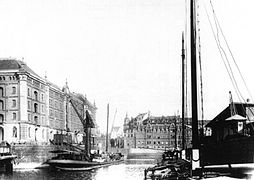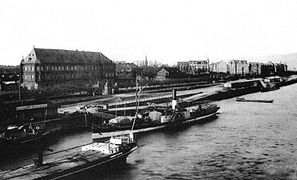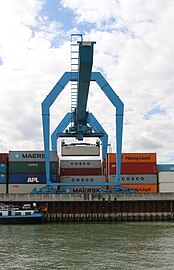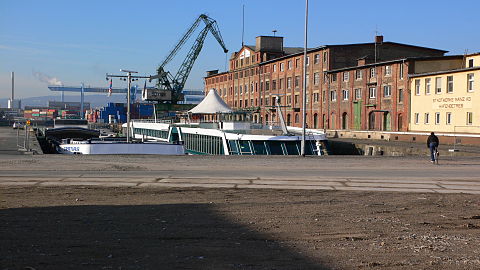Customs and inland port of Mainz
| Customs and inland port of Mainz | |||
|---|---|---|---|
| Data | |||
| UN / LOCODE | DE MAY | ||
| owner | City of Mainz | ||
| operator | Zollhafen Mainz GmbH & Co. KG | ||
| opening | Antiquity | ||
| Port type | Port and lands | ||
| website | http://zollhafen-mainz.de/de/ | ||
| Geographic information | |||
| place | Mainz | ||
| country | Rhineland-Palatinate | ||
| Country | Germany | ||
| The historic customs port in transition to a modern container and inland port; 2008 | |||
| Coordinates | 50 ° 0 '55 " N , 8 ° 15' 33" E | ||
|
|||
The customs and inland port of the city of Mainz was one of the four Mainz ports, which are divided into three port operations: customs and inland port ( Ingelheimer Aue ), Rheinreede ( Mainz-Weisenau ) and industrial port ( Mombach ), as well as the winter port leisure area. The commercial port area stretched from Rhine kilometers 499.100 to 503.701.
history
Roman time
The Roman naval port and a center for merchants with warehouses and storerooms were located on the site . The area is known as "Dimesser Ort" (after St. Theonest ). It is believed that the first Christians in the Roman Mogontiacum stayed here.
19th century
The Mainz wine merchant Heinrich von Mappes personally campaigned against Napoléon Bonaparte for the restoration of the Mainz free port and the establishment of a customs warehouse at the Electoral Palace . The Mainz city planner Eustache de Saint-Far therefore had the Martinsburg demolished in 1809 in order to build bridges and ports. This was one of the infrastructure measures for the canton of Mainz in what was then Eastern France. From the stones recovered during the demolition, the ship wintering was built directly at the customs office at the former electoral palace.
In 1804 the regulation of the most important waterway in Europe began with the Rhine Convention. It was agreed that the river would be 500 meters wide. In 1815, the final act of the Congress of Vienna called for freedom of navigation for international waters and the establishment of a commission for the Rhine. This central commission for navigation on the Rhine met for the first time in 1816 in Mainz. The Mainz Act was agreed on March 31, 1831 . In 1861 the commission was moved to Mannheim . On October 17, 1868, the Mannheim Act was signed by Baden , Bavaria , France , Hesse , the Netherlands and Prussia , the principles of which are still valid today. The customs and inland port was built in the course of this regulation of the Rhine with extensive bank embankments according to the plans of city architect Eduard Kreyssig between 1880 and 1887. These replaced the electoral palace , which until 1886 had to serve in part as a warehouse for the adjacent free port. The track systems ensured the connection to the railway network. The port buildings and depots in the north of the city were built at a cost of 5 million marks and opened to traffic in 1887. Today's industrial port was built as a raft port from 1882 to 1887 by partially filling in the arm of the Rhine to Ingelheimer Aue to create the basin for the Mainz customs and inland port upstream. In 1885, 7,887 ships (including 3,930 steamships) and 1,032 rafts with 181,276 tons of cargo arrived in Mainz. Logging was an important industry at that time. Another port, then owned by the Hessian Ludwig Railway, was built across from Mainz, at the mouth of the Main near Gustavsburg.
During the founding period , trade was particularly lively in relation to books and music, grain, flour, oil, wine and industrial products.
20th century
After the Second World War , the northern port basin of the industrial port was made smaller by filling it with war debris.
Mid-80s lost the cargo - and bulk envelope in importance relative to the container - envelope , which is largely Rhine side.
The quay walls made of basalt lava and the staircases on the southern edge of the harbor basin have been preserved from the time it was built. The former machine and boiler house (today's Kunsthalle Mainz) and the wine storage building on the south pier are also still there today.
21st century
In 2011 the port operations had an area of 30 hectares. In 2006 the customs and inland port had a turnover of 1.43 million t. He was approached by 1,381 ships. In the ranking of container throughput for the ten most important inland shipping ports, Mainz was fifth among the most heavily handled inland ports in Germany with 112,964 TEU .
Container handling was relocated down the Rhine to the Ingelheimer Aue. The last containers were moved in 2011. The attractive port area was expanded into a residential area. In 2008 the municipal art gallery moved into the machine and boiler house at the harbor - built in 1887 . The historic wine warehouse on the south pier was completely renovated and converted into office space. The development of further sections of the customs port began in 2013. Until 2017 only the southern part facing the old town was built on and the northern part was freed from warehouse buildings. Due to the size of the building plots being marketed and the sharp rise in land prices, only commercial real estate marketers have been involved so far. When fully developed, the new area of the Neustadt should have space for around 1,400 residents. Converted to a residential area, residents in a citizens' initiative are resisting the planned new construction of a ship berth for up to 16 cargo ships with day and night operation directly in front of the new residential buildings and a car drop-off area in front of Feldbergplatz. They expect considerable noise and exhaust emissions as well as an obstructed view of the Rhine for the entire Neustadt district of Mainz and are demanding an environmental impact assessment that has not yet been carried out.
meaning
Mainly containers, sand, gravel and grain are handled in the Mainz ports. In addition, there is the transshipment of products from the mineral oil industry. The tax and customs regulations required the port area to be separated from the rest of the city by means of an iron fence. This was the only way to control the inbound and outbound transport of goods.
building
The five-story warehouse of the tax office was built as an imposing port building in 1894 on the headland in the south between the two staircases. It was canceled in 1968. Currently, the tallest building is the listed wine warehouse at Hafengarten, which was rebuilt after gutting in 2011 and since May 2012 has been the headquarters of the federal office of the Association of German Predicate and Quality Wineries .
Equipment and handling facilities
- Container cranes with a lifting force of up to 40 t (5 ×)
- Extinguishing systems for mineral oil products (2 ×)
- pneumatic systems for grain and oilseeds (2 ×)
Infrastructure
With the port railway and Rheinallee, with a connection via Mombach to the motorways via the A 643 , the port operations are well and inexpensively connected to the most important sales and procurement markets at home and abroad and make an important contribution to relieving the roads in long-distance freight transport .
In a nationwide comparison, the Mainz container port ranks among the top 10 of a total of 100 inland ports in Germany in terms of total handling volume.
New container terminal
Due to the economic structural change, the areas of the Mainz customs and inland port were up for grabs. The old port area is intended for urban development as a new part of Mainzer-Neustadt . In its place, a new city quarter with Kulturspange Kunsthalle Mainz will be built on the old Kesselhaus as an event location and marina .
With the completion of the new, more efficient container terminal at the height of the Rhine kilometer 501 on the Ingelheimer Aue north of the Kaiserbrücke in the spring of 2011, the customs port close to the city center was given up. The creation of sufficient space potential for the new container terminal was agreed between the operating company Frankenbach and Stadtwerke Mainz AG as the property owner in order to create a facility whose area has long-term expansion options. A new Rhine roadstead was created over a length of approx. 522 m on the bank zone. Due to the parallel port railway, this is ideally suited for a new quay and thus offers optimal conditions for a trimodal transshipment facility for combined cargo traffic. The usable area of today's area is around 80,000 m², which is suitable for storage of 10,300 TEU. Four container cranes on the river side and a container bridge on the shore enable the handling of 454,400 TEU pa In addition to the train movements, around 700 truck movements are planned per day. After commissioning, 36 fixed cooling connections will be available for the handling of reefers , the capacity of which can be doubled. The state of Rhineland-Palatinate subsidized the new connection via the port railway with € 9 million. The remaining costs of € 21 million are shared by the operator Frankenbach (75%) in cooperation with the Stadtwerke Mainz AG group (25%) as the landowner. The port-to-port transport times to the port of Rotterdam are 24 hours downhill and 60 hours uphill from Rotterdam.
Flooded railroad tracks at the customs and inland port of Mainz during the floods in Central Europe in 2013
Web links
- https://www.zollhafen-mainz.de/ Website of the new city quarter
- mainz.de - Info City Mainz
- Frankenbach - Terminal Mainz
Individual evidence
- ↑ Helmut Mathy : Kurmainzer viticulture and wine trade policy from the 17th to the 19th century in: Viticulture, wine trade and wine culture. Stuttgart 1993. (Geschichtliche Landeskunde. Vol. 40.), pp. 187–222.
- ^ Property development Zollhafen Mainz GmbH & Co. KG, accessed on July 1, 2017
- ↑ Mainz: New container terminal inaugurated on Ingelheimer Aue, Mainzer Allgemeine Zeitung on May 27, 2011 ( Memento from October 1, 2011 in the Internet Archive )
















